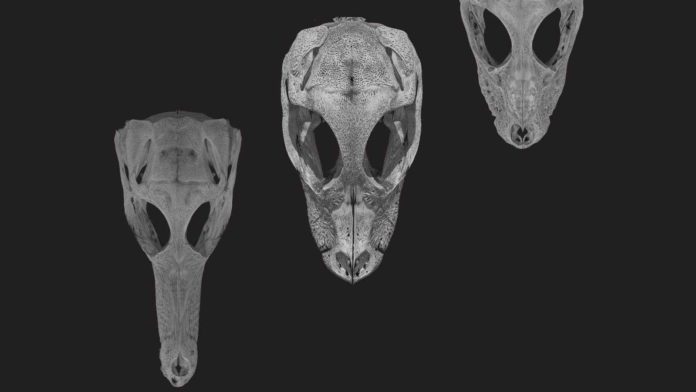Crocodiles are large reptiles that live in water. These modern relatives of dinosaurs- have living fossils that remained virtually unchanged for millions of years. Anyone can quickly recognize them due to their flattened skulls with tooth-filled jaws.
Historically, skull shape has been used to categorize species into distinct ecomorphs: long snouts for eating fish; short snouts for harder prey; and moderate snouts for large prey.
How is such broadscale convergence generated?
In a new study by the Harvard Gazette, scientists tackled this question by comparing embryonic development with later growth in all species of living crocodiles. They found that the diversity of skull shapes found today was realized by altering developmental patterns during evolution.
This discovery shed light on the mechanisms underlying convergent snout evolution.
Stephanie Pierce, associate professor of Organismic and Evolutionary Biology said, “This study is just a snapshot of crocodile evolution. But it shows they have been tinkering with their developmental strategy in order to adapt to their environment, so they can be as successful as possible.”
Zachary Morris, Ph.D. ’20 said, “Crocodiles are often thought to be unchanged by time, but our analysis instead suggests that they have evolved a very flexible developmental tool kit. So given enough time and selective pressure they are able to alter the rate and timing of development, resulting in ecologically different forms with long, short, and moderate snout shapes.”
“And importantly, those general shapes aren’t limited to living crocodiles. They have evolved independently multiple times in the fossil record.”
Pierce said, “There’s a great deal of convergence that wasn’t initially appreciated. In the past, the shape of the skull was used to assign evolutionary relationships, so if an animal was short-snouted, it was [thought to be] related to all the other short-snouted species.”
“But with modern analyses, we’ve been able to determine that many of the animals that have similarly shaped snouts are actually not related to one another. The independent acquisition of the same snout shape is presumably due to having similar ecological pressures, such as eating similar foods.”
Morris said, “Whatever those pressures are, the similarities in adult skull shapes must be underpinned by changes in the developmental patterning and growth of the skull.”
“We know, in a general sense, that an important part of what makes an alligator different from a gharial or a dwarf African crocodile has to do with changes to ontogeny, or the embryonic development and post-hatching growth.”
“Given that these different forms have evolved independently multiple times, we have the opportunity to see whether there are fundamental mechanisms underlying the evolution of those shapes.”
Pierce said, “Essentially, Pierce said, that was the question she and Morris set out to answer in the paper — whether the ontogenetic paths various crocodile species take to achieve their adult forms are similar to or different from one another.”
“What we’re trying to understand is how crocodiles do it — how do they converge, as adults, on these same shapes? Are they doing it very early in embryonic development or does it happen later on?”
During the study, scientists CT scanned dozens of crocodile embryos, photographed post-hatching specimens held in museums around the globe, and digitized anatomical coordinates on each skull at specific locations so he could track how their shapes changed through development.
Morris said, “It was not a trivial thing to sort out how to do this because in the very youngest embryonic specimens, they only have very tiny, thin splints of bone.”
In the end, scientists identified landmarks,” or identifiable points, for every specimen. They also tracked how those changed throughout their development as embryos and into adulthood.
Morris said, “One of the really interesting results we found is that, with the exception of two of the most extreme short-snouted forms, all other crocodiles start from the same embryonic starting point. They’re able to make, as adults, a huge range of functionally different shapes from this same starting point.”
“What we found was that the ontogenetic trajectories of short forms are essentially identical to each other. But that’s not true for the long-snouted forms. They have very similar adult shapes, but they have very, very different ways of getting there.”
By taking their analysis further, scientists used ontogenetic trajectories of living crocs to backtrack through time to investigate the developmental pattern of the last common ancestor of modern crocodiles. They found that the ancestral crocodile was likely moderate-snouted, similar to the generalist crocodiles found today.
Morris said, “So what’s really interesting is if the ancestral trajectory is similar to the generalized crocodiles, then somewhere along the evolutionary branches leading to the short and long forms there must have been changes in the developmental pattern.”
Pierce said, “Excitingly, we were able to show that short-snouted species slowed down their development from the ancestral crocodile in similar ways, while long-snouted species either sped up development or started off with much longer snouts as embryos. Essentially, slightly dialing up or down the rate and timing of development during evolution resulted in the diversity of skull shapes we see today.”
Scientists are further planning to extend their exploration as a component of a push to comprehend the advancement of the whole crocodilian line and to keep considering embryonic improvement in modern crocodiles with the objective of distinguishing the genetic signs that underlie changes in skull shape.
The study is described in a Feb. 20 paper published in the Proceedings of the Royal Society B.
